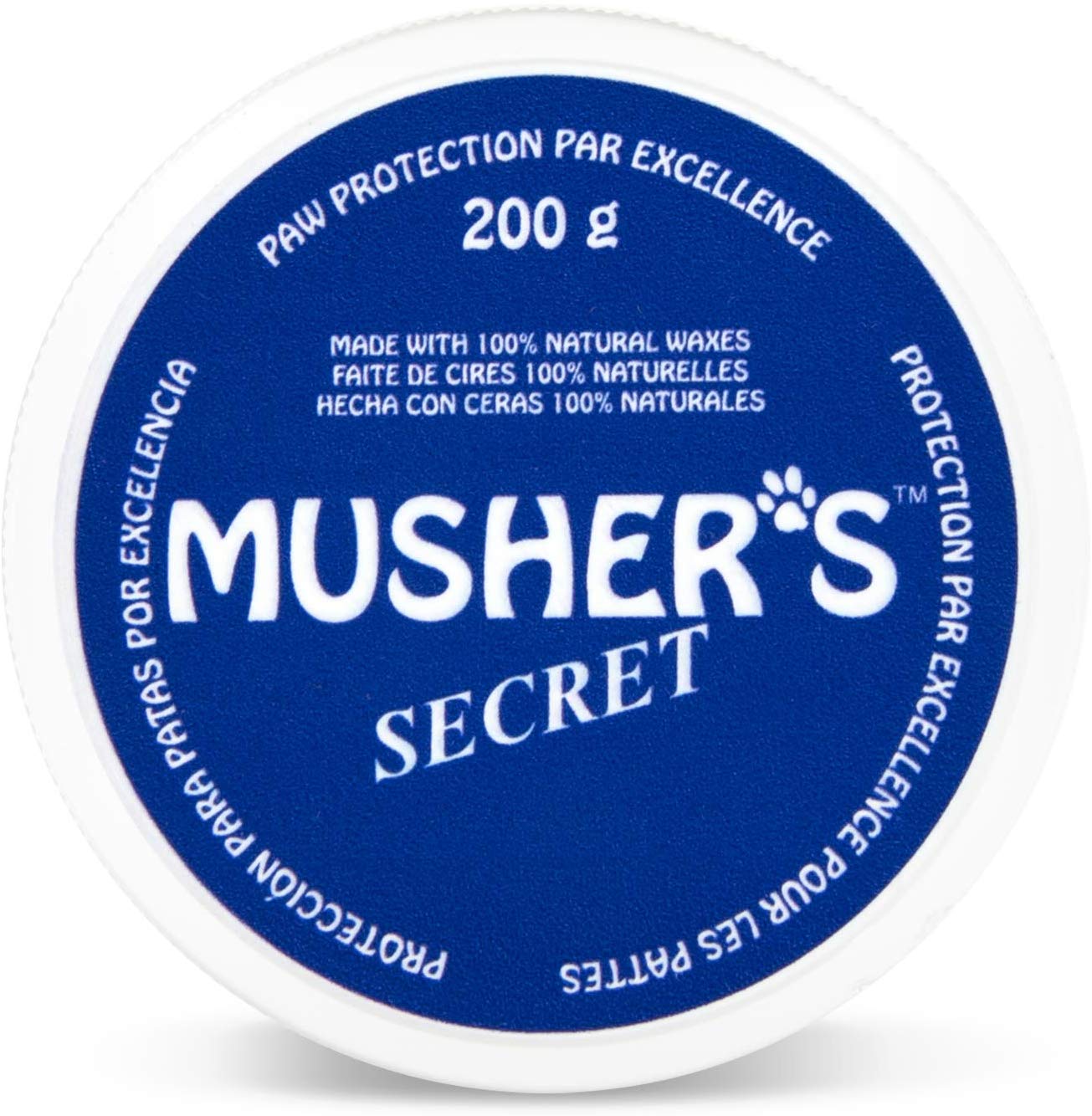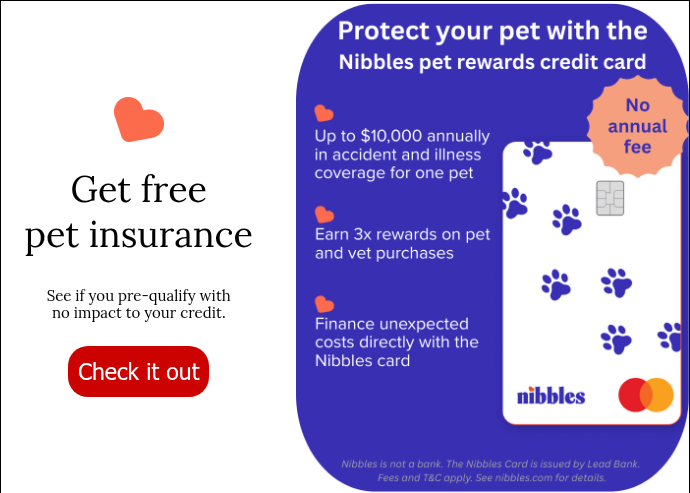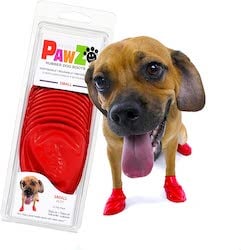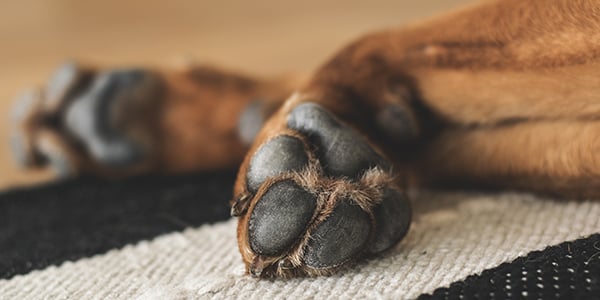 Let’s talk about paw pads! Foot care is just as important for our dogs as it is for us humans — dogs can suffer from blisters or torn paw pads, burnt paws from walking on pavement that’s too hot, or mats between their toes. Ouch!
Let’s talk about paw pads! Foot care is just as important for our dogs as it is for us humans — dogs can suffer from blisters or torn paw pads, burnt paws from walking on pavement that’s too hot, or mats between their toes. Ouch!
Injured paw pads make walking painful and can get infected, and mats between their toes can cause walking problems or a variety of skin issues if your dog licks at them.
It’s important to properly care for your dog’s feet beyond making sure their nails are trimmed, and it’s pretty simple!
Caring for your dog's paw pads is important year-round, but especially so during snowy and icy winter weather or during hot summer weather.
Table of Contents
What Exactly Are Paw Pads?
A dog's paw pads consist of a layer of pigmented skin, usually pink or black, covering fatty tissue. Since fat is insulating, these give your pup's paws a bit of protection from colder surfaces in the winter.
They’re also an integral part of your dog’s foot structure and work in conjunction with your dog’s nails (which provide protection for the pads). Paw pads help with your dog’s balance and provide traction, stability, and shock absorption, too.
You might notice that your dog’s paw pads are rough and calloused or smooth and soft — this all depends on the terrain your dog regularly walks on. If you take your dog hiking often, or they take regular walks out on asphalt, they’ll have more calloused paw pads due to the exposure to rougher terrain.
If your dog is older and doesn’t walk as much or spends most of their outside time running around on grass, their paw pads are likely to be smoother (and more likely to tear when they do walk on rougher surfaces).
Just as we humans can build up calluses by incremental exposure to rough surfaces, you can do the same with your dog if you plan on frequent hikes or know they’ll be walking on rougher surfaces throughout their life. Start with shorter periods of time on these surfaces to let the pad build up toughness over time.
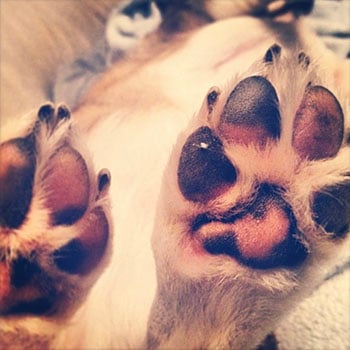
Paw Pad Maintenance and Care
Make it a habit to check your dog’s paw pads regularly.
Gently spread their toes apart and inspect the sides of their paw pads and between their toes for any injuries or foreign objects (like burrs, pebbles, or dangerous foxtails). It’s also a good time to check for any swelling or discoloration.
Watch to see if your dog shows any signs that they are in pain or have tenderness when examining their foot.
Questions? To chat with a veterinarian about your dog's paw health, Click here
Avoid Walking Your Dog on Hot Pavement
Hot pavement or asphalt can burn your dog's paw pads. You can easily check to see if the ground is too hot for your dog to walk on by placing the back of your hand flat on the pavement and trying to hold it there for 7 seconds.
If it’s too hot for you to keep it there for the full time, it’s too hot for your dog to walk on! If the pavement is that hot, it’s probably too hot for a dog walk or other outdoor activities.
Keep your dog's potty walks during hot weather short; try to walk your dog on grass and in the shade, and have lots of cool, fresh water available for frequent rehydration.

True Story: July 2024 in Las Vegas, about half the (human) patients in the burn unit at University Medical Center were being treated for pavement burns. During this CBC Mornings news story they tested the pavement, and it was 163 degrees. It only takes seconds for a 2nd-degree burn to happen, and it happens to pets too!
How to Care for Your Dog's Paws in Winter
Winter can also be tough on your dog’s paw pads with snow, ice, and salt. No ice-melt product is completely safe for your dog, and many can cause your dog’s paw pads to dry out, crack, or even burn, and can be toxic if your dog ingests it by licking it off their paws.
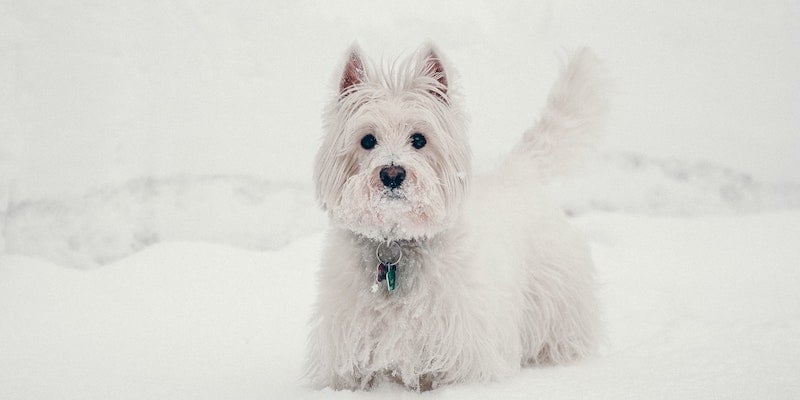
Try to avoid walking them on salt-treated sidewalks if possible. Click here to learn more about which ice melters are safer for your pet if you need to de-ice your driveway or sidewalk.
- Keep your dog's paw pads trimmed of excess fur between their toes. This way, they won't collect paw "snowballs" between their toes as easily. These snowballs form when snow and ice get wrapped up in dog fur, melt from their body heat, and then refreeze.
Snowballs on your dog's feet and legs can cause a lot of pain and discomfort since they are pushing your dog's toes apart and pulling on the hair. See below for our cordless trimmer suggestion, one that many groomers use. - Have your dog wear booties outside during the winter. Or, if they don't tolerate boots, apply paw wax prior to going outside in the snow or ice.
Check out my top picks for dog boots, including disposable options, further below. - Wash and dry your dog's paws after any trip outside – especially if they've been walking on salt-treated surfaces. If your dog's paws have collected snowballs, use some paw wax to slide the ice out from between their toes before washing with warm water.
A portable paw washer, like the Dexas Mudbuster, can give you a quick and easy way to wash off your pup's paws with less mess!
Protect Your Dog's Paws with Paw Wax
An easy way to protect your dog’s paws is to use paw pad waxes, which are a great option if your dog doesn’t tolerate wearing booties or you can't find one that stays on.
Paw pad wax, like Musher’s Secret (originally created for working sled dogs), is easy to apply and moisturizes their paw pad, creating a barrier around your dog’s foot that repels ice, salt, dirt, and helps protect your dog’s paw pad from burns.
Think of it as an invisible boot! Apply to their paws just before heading outside. If you are worried about your dog's paw pads in snowy or icy conditions but don't have a paw wax handy, you can also use Bag Balm.
Should You Moisturize Your Dog's Paws?
You should moisturize your dog's paw pads if they are cracked, peeling, or too dry. Use a paw balm to help your dog's paw pads heal and soften, like this Paw Soother Stick.
Another great product that our team veterinarian recommends is Bag Balm, and it's not just for use on dogs.

Avoid using human lotions or moisturizers that haven't been approved by your veterinarian. Try to stick with products made specifically for canine paws to ensure there are no toxic ingredients or irritants.
Be careful not to overdo it — if your dog already has soft paw pads, moisturizing them can make them more susceptible to tearing or ripping when they walk on rough or wet surfaces.
If your dog has an abrasion or cuts on their paw pad, it's always best to have it checked out by your veterinarian to make sure it doesn't get infected.
They may recommend wrapping it or covering it with a silicone scar sheet to protect it while it heals. Simply cut the scar sheet in the shape of your dog's affected pad and apply.
Keeping Your Dog's Paw Pads Trimmed and Mat-Free
Keeping the fur or hair that grows between your dog’s paw pads nice and short can also help to keep their feet healthy and provide more traction on slippery surfaces.
When their paw pads are trimmed, it’s easier for you to inspect and clean their paws, and it keeps ice build-up from between their toes during snowy weather. It also helps to prevent any matting between your dog’s toes, which can be painful and cause your dog to chew at their feet (which leads to hot spots and other skin issues).
Some dogs don’t have much fur growing on the bottom of their feet, but medium to thick-coated dogs tend to have fuzzy feet that can benefit from trimming.
It's easy to trim your dog's paw pads at home using grooming clippers! I personally recommend the Wahl Bravura clippers for paw pad trims (and even sanitary – aka "poop chute" – trims if your dog needs them).
Because it's cordless, it's easy to use and has a 5-in-1 blade with different length options. The #10 length setting is the best length for paw pad trims.
If possible, have a helper distract your dog with yummy treats while you trim their paw pads. If it's just you, though, use a licking mat or a stuffed Toppl feeder to distract them while you work. It's okay to just do one paw pad trim a day if that's all your dog can handle.
Watch Preventive Vet's office dog Finnegan (a Portuguese Water Dog with incredibly fluffy feet) get his paws trimmed at home with the Wahl Bravura in this video:
Check out this video from Love of Grooming to see a groomer explain the holding and scooping technique:
Pro Tip: Preventing mats is much better than having to shave and trim them out! The easiest way to prevent matting is to keep their coat thoroughly brushed.
If you have a breed or breed mix whose coat is prone to matting and tangling, make sure to brush out their legs, feet, and between their toes frequently — especially after getting wet! Moisture causes a dog's coat to curl and twist around itself, which results in mats galore if it isn't brushed out while drying.
Toe Tangles and Mats
If you notice that your dog has a mat between their toes or between their paw pads, you can try using olive oil to loosen the mat, or if your dog allows it, try gently combing it out.
Often a dog will not tolerate having a foot mat combed out, as it can be extremely painful. I recommend having a professional groomer help you with any matting on your dog’s feet*.
*Grooming Safety Warning: Scissors can cause injury to your dog during grooming. Do not use scissors to try and trim paw pads or trim out mats unless you are properly trained in these grooming techniques, have the proper tools, and feel comfortable doing so. Dogs can be very sensitive about their feet and might be extra wiggly when you’re holding their paws.
Using scissors instead of clippers to trim out any matting often results in injury. If that happens you’ll need to go to the veterinarian for treatment and medication to prevent infection (which can be costly), plus your dog will be much less willing to be handled the next time. It’s oftentimes easier and safer to leave mat trimming to the professionals.
Protect Your Dog's Paws with Dog Boots
A paw pad injury can be very painful for your dog, whether it’s from ripping a paw pad during excessive running and play, cutting a pad while on a hike, ice build-up between their pads, or burning and blistering from walking on hot surfaces.
The best way to protect your dog’s paw pads from wear and tear is to have your dog wear booties when they are participating in activities or in environments that could damage their pads. Look for a sturdy, well-fitted, and non-slip boot for your pup.
These PawZ dog boots are great disposable dog booties that provide protection against hot pavement, rain, snow, and environmental allergies and provide traction for senior pets.
They are available in a variety of sizes (there's even a "tiny" size for teacup breeds or puppy feet!) and in packs of 12. Each boot can be reused multiple times before tossing.
PRO TIP: Many senior dogs wear these PawZ boots for extra traction around the home. To allow for airflow around the paw pad, simply use a hole puncher to punch one or two holes in the bottom of the bootie.
While this does take away the waterproof feature of the boots, it allows for longer indoor wear without stinky or sweaty paws.
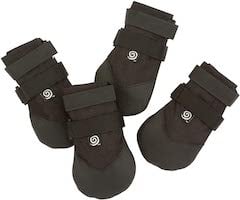
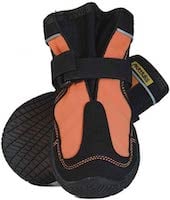
How to Help Your Dog Get Used to Wearing Boots
It’s always a good idea to introduce booties slowly with some desensitization techniques to help your dog feel less stressed by their new kicks and more comfortable moving about in them.
Watch this video to see how easy it is to teach your dog to love wearing their boots:
Safety Note: Never wrap your dog's paws in masking tape or duct tape. Not only can this be uncomfortable and painful for your dog because it sticks to their fur and skin, but it prevents airflow to their skin and affects their natural gait.
How Paw Pads & Nails Help Your Dog's Mobility
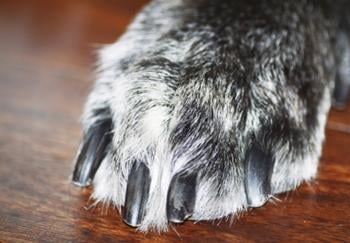
Traction is especially important for senior dogs and those with osteoarthritis! A dog's paw pads provide some natural traction, but their nails actually play a larger role in traction on slippery surfaces, balance, and gait.
Are Traction Pads, Coating, or Powders Worth It?
You may have seen products that you apply to your dog's pads to provide more traction, from stickers to powders. These aren't ideal because dogs sweat through their paw pads and shouldn't be covered, especially long-term.
Unlike the exterior of a dog's toenails, paw pads are full of nerves and more touch-sensitive, so we don’t know how these materials impact the dog's sensation and comfort.
Paw pad solutions are notorious for falling off quickly (generally within one week or less) and need to be reapplied often. Ultimately, they can help with traction, but they don't take into account that nails, not paw pads, are a dog's primary traction mechanism.
What's Best for Better Traction?
When your dog starts to slip, their natural reaction is to engage their nails to steady themselves. This works well in certain environments, such as outdoors in the grass or dirt.
But on surfaces like tile, wood floors, laminate, or concrete, it's much harder for them to "get a grip!" One way to help increase traction is to have your dog wear nail grips. We love Dr. Buzby's toegrips.
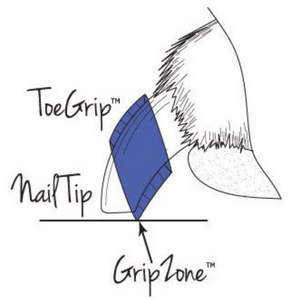
Nail grips help your dog gain traction when getting up or walking on slippery surfaces by providing a point of contact (and, therefore, traction) between the nail and the floor.
Nail grips also don't interfere with your dog's paw pads and are easier for your dog to wear compared to booties. Once fitted, they typically last a couple of months before needing to be replaced.
It's essential to keep your senior dog's nails at a short length. Too long, and they can change the way they stand and walk, putting uncomfortable pressure on their feet and joints.
Untrimmed nails can curl under and grow into a dog's paw pad (most often seen with dewclaws), split, or get caught on carpet or other materials and be ripped out.
Combine regular nail trims with trimming your aging dog's paw pad fur regularly and putting out floor mats or carpets so they can get around your home with less slipping.
Wearing dog booties, like those featured above, may also help prevent them from sliding around on tile or wood floors but won't provide as much help as nail traction support.
For more tips on helping your dog stay mobile, check out How to Help an Older Dog with Arthritis or Mobility Issues.
Common Dog Paw Issues
Smelly Paws
Dog paws can smell for a variety of reasons. They have sweat glands in their paw pads that help them cool down in hot weather, and they have scent glands as well that let them leave behind their pheromones so others know they were there (which is why many dogs scrape their feet on the grass or kick the dirt after going to the bathroom).
More commonly, people complain (and others find it oddly comforting) that their dog's feet smell like corn chips. This smell is from bacteria or yeast on your dog's feet, usually between their toes and paw pads.
If you notice a smell, inspect your dog's toes between the paw pads and the base of the nail bed. Infected nails may be brittle, irregular, or soft. There may be discoloration and a "film" over the nail or mild to moderate swelling at the nail bed.
Yeast and bacteria on your dog's feet are normal, and your dog's immune system works to keep them at a manageable number. However, if you're noticing that your dog's paws really reek of Fritos® or their nails appear infected, visit your veterinarian to find out the cause and treat the infection.
Sometimes, these infections are caused by food or environmental allergies. Make sure to thoroughly wipe and dry off your dog's paws after they take a trip outside to help prevent an overload of yeast and bacteria between their toes.
Hear us lament over Frito-toes in our music parody video, "Toe Beans."
Hyperkeratosis
Do your dog's paw pads look rough, thick, or crusty? Does it look like they've got fur growing from their paw pads? This is called canine hyperkeratosis, and you might see it on their paw pads or on their nose.
Hyperkeratosis can be genetic or the result of an underlying medical condition, so it's important you speak with your vet if you notice it. In the meantime, you can keep your dog's paws moisturized and protected with paw pad balm to reduce your dog's discomfort.
Ripped Paw Pad
This problem recently happened to a team member's dog. They're not sure how it happened, but he started limping. After checking his paw pad, it was apparent that he had ripped off a piece somehow.
It could have been while running on his treadmill or even running and rubbing it on the concrete or carpet.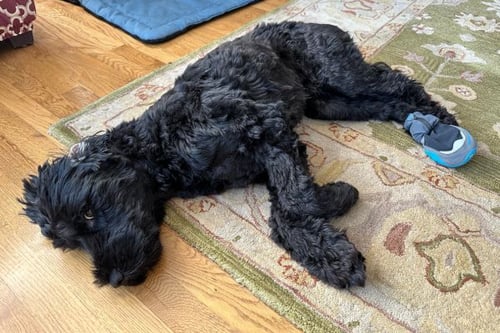
Regardless of the cause, the solution to help it heal as quickly as possible is pretty much the same.
- Soak in warm water with Epsom salts once daily for 15 to 20 minutes until healing begins. For Finnegan, a tall plastic juice container was used to make it easier. He seemed to enjoy it.
- Thoroughly rinse the entire area that was soaked and dry completely.
- Put triple-antibiotic ointment, like Neosporin, on the area twice daily.
- Have your dog wear a sock (can be one of yours) to protect it or a dog boot. Or have them wear a cone to protect them from getting at their paw while it's healing.
Finnegan's paw took around 3 weeks to heal until he didn't need the boot to protect it anymore. It didn't bleed, but he was in a considerable amount of pain and discomfort at first.
You can see the healing progression in the photos below. The middle photo has Bag Balm on his paw to provide some extra soothing.



